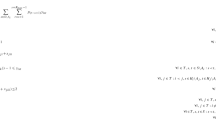Abstract
The goal of a melon harvesting robot is to maximize the number of melons it harvests given a progressive speed. Selecting the sequence of melons that yields this maximum is an example of the orienteering problem with time windows. We present a dynamic programming-based algorithm that yields a strictly optimal solution to this problem. In contrast to similar methods, this algorithm utilizes the unique properties of the robotic harvesting task, such as uniform gain per vertex and time windows, to expand domination criteria and quicken the optimal path selection process. We prove that the complexity of this algorithm is linearithmic in the number of melons and can be implemented online if there is a bound on the density. The results of this algorithm are demonstrated to be significantly better than the standard heuristic solution for a wide range of harvesting robot scenarios.











Similar content being viewed by others
Notes
The argument of \(x_{ij}^{*}(t)\) is taken relative to the time it commences the traversal. Thus, \(t=0\) when the manipulator begins at melon i and \(t = T_{ij}\) when it concludes at melon j.
We add the suffix \({\vert }_{t}\) to an array’s symbol whenever the event handler’s time t is necessary for defining the array, or another entity based on the array. Thus, A(v) is \( A(v){\vert }_{t}\), as B(P) is \(B(P){\vert }_{t}\).
The degree of a node is the number of arcs incident to the node.
References
Belforte, G., Gay, P., Aimonino, D.R.: In Industrial Robotics: Programming, Simulation and Applications, pp. 677–690. Pro Literatur Verlag, Germany/ARS, Austria (2006)
Edan, Y., Han, S., Kondo, N.: Handbook of Automation. Springer, Berlin (2008)
Sarig, Y.: Robotics of fruit Harvesting—a state of the art review. J. Agric. Eng. Res. 54, 265–280 (1993)
Mann, M.P., Rubinstein, D., Shmulevich, I., Zion, B.: Motion planning of a mobile Cartesian manipulator for optimal harvesting of 2-d crops. Trans. ASABE 57(1), 283–295 (2014)
Feillet, D., Dejax, P., Gendreau, M.: Traveling salesman problems with profits. Trans. Sci. 39(2), 188–205 (2005)
Tsiligirides, T.: Heuristic methods applied to orienteering. J. Oper. Res. Soc. 35(9), 797–809 (1984)
Vansteenwegen, P., Souffriau, W., Oudheusen, D.V.: The orienteering problem: a survey. Eur. J. Oper. Res. 209, 1–10 (2011)
Kantor, M.G., Rosenwein, M.B.: The orienteering problem with time windows. J. Oper. Res. Soc. 43(6), 629–635 (1992)
Bansal, N., Chawla, S., Blum, A., Meyerson, A.: Approximation Algorithms for Deadline TSP and Vehicle Routing with Time Windows, presented at 36th ACM Symposium on Theory of Computing, Chicago, IL, 2004 (unpublished)
Chekuri, C., Korula, N.: Approximation Algorithms for Orienteering with Time Windows. arXiv preprint (2007)
Bar-Yehuda, R., Even, G., Shahar, S.: On approximating a geometric prize-collecting traveling salesman problem with time windows. J. Algoritm. 55, 76–92 (2005)
Righini, G., Salani, M.: New dynamic programming algorithms for the resource-constrained elementary shortest path problem. Networks 51, 155–170 (2008)
Righini, G., Salani, M.: Decremental state space relaxation strategies and initialization heuristics for solving the orienteering problem with time windows with dynamic programming. Comput. Oper. Res. 36, 1191–1203 (2009)
Desrochers, M.: An algorithm for the shortest path problem with resource constraints. Technical Report (1988)
Zhu, X.: The Dynamic, Resource-Constrained Shortest Path Problem On An Acyclic Graph With Application In Column Generation And A Literature Review On Sequence-Dependent Scheduling. Ph.D. dissertation, (2005)
Feillet, D., Dejax, P., Gendreau, M., Gueguen, C.: An exact algorithm for the elementary shortest path problem with resource constraints: application to some vehicle routing problems. Networks 44(3), 216–229 (2004)
Irnich, S., Desaulniers, G.: Shortest Path Problems with Resource Constraints. Springer, Berlin (2005)
Naidu, D.S.: Optimal Control Systems. CRC Press, Boca Raton (2003)
Irnich, S.: The shortest-path problem with resource constraints and \(k\)-cycle elimination for \(k{\>}3\). INFORMS J. Comput. 18(3), 391–406 (2004)
Cormen, T.H., Leiserson, C.E., Rivest, R.L., Stein, C.: Introduction to Algorithms. MIT Press, Cambridge (2003)
Mann, M.P., Rubinstein, D., Shmulevich, I., Zion, B.: Determination of robotic melon harvesting efficiency: a probabilistic approach. Submitt. Int. J. Prod. Res. (2015)
Acknowledgments
The authors would like to thank the Israeli Ministry of Agriculture and Rural Development and the Irwin and Joan Jacobs Graduate School of the Technion for their partial support of this research.
Author information
Authors and Affiliations
Corresponding author
Rights and permissions
About this article
Cite this article
Mann, M., Zion, B., Rubinstein, D. et al. The Orienteering Problem with Time Windows Applied to Robotic Melon Harvesting. J Optim Theory Appl 168, 246–267 (2016). https://doi.org/10.1007/s10957-015-0767-z
Received:
Accepted:
Published:
Issue Date:
DOI: https://doi.org/10.1007/s10957-015-0767-z




